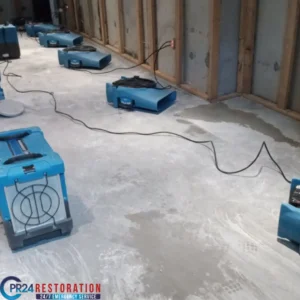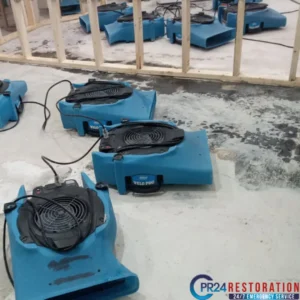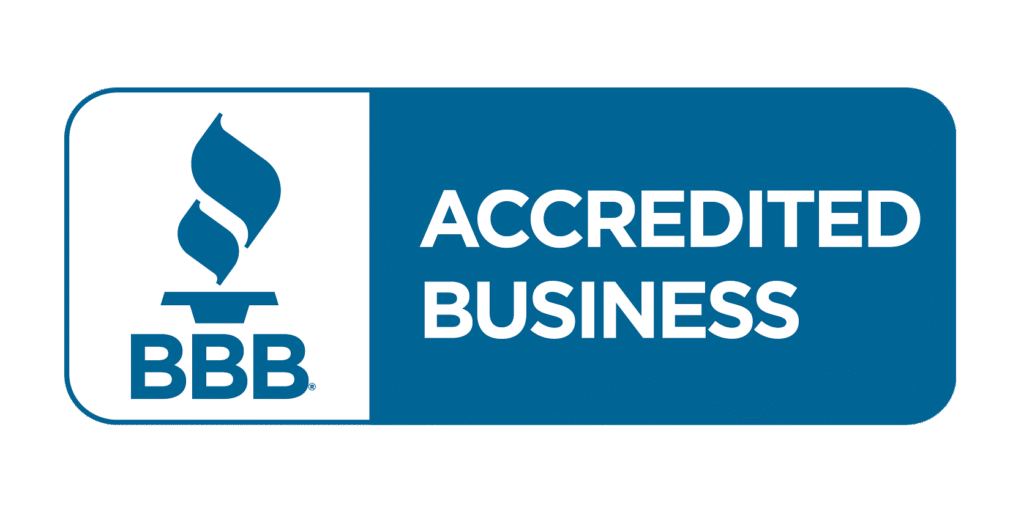Basement Flooding Aurora
Basement Flooding Aurora
Your basement could flood anytime, but the risk increases during spring as melting snow combines with heavy rain. Aurora homeowners know how stressful these situations can be.
Water can build up in your basement because of unexpected sewer blockages, even during dry weather. The damage from basement water becomes more serious quickly. Dangerous mold starts growing within 48 hours of water exposure.
CPR24 Restoration has identified the main reasons basements flood, and we’ll share simple ways to prevent it here.

Contact Us Today
4 Key Causes of Basement Flooding Aurora
These are the 4 main reasons basement in Aurora will flood:
Water flow from rain and snowmelt
Water from rainfall and snowmelt flows over land toward your property, causing overland flooding. Aurora’s changing climate makes this a significant concern. Your property’s slope plays a substantial role in directing water toward or away from your foundation.
Overland flooding remains the most common reason for basement water problems in Canada. Water can enter through rising levels from nearby water bodies, excess snowmelt, or heavy rainstorms. Water typically enters your home at or above ground level, which makes proper lot grading essential.
You need to ensure your lot has the right grading to direct water flow away from your home and into the storm sewer system. Water can pool around your foundation and seep inside without proper drainage.
Groundwater infiltration through foundation cracks
Groundwater leaks into basements through openings in the foundation structure. Foundation walls or floor slabs often develop cracks, especially in older homes.
Aurora has clay-rich soils and often experiences freeze-thaw cycles. This makes homes more likely to have foundation cracks and water problems. Even homes with strong drainage systems can have problems because these small openings let water seep in.
Hydrostatic pressure also plays a key role. Saturated soil around your foundation creates pressure against basement walls and forces moisture through cracks or weak spots. This pressure builds up slowly after long periods of rain or faster during storms.
Sewer backups from blockages or pipe failure
Sewer backups are the third main cause of basement flooding Aurora. Blockages in sanitary sewer pipes prevent water from flowing properly. These obstructions happen because of soil settlement, misaligned pipe joints, root infiltration, or complete pipe collapses.
Blockages can occur in your private sewer pipe or the Town’s main sanitary line. On private property, cooking grease, rags, toys, and “flushable” wipes build up over time. Public infrastructure faces similar issues with collapsed pipes or the buildup of improperly disposed materials that affect entire neighbourhoods.
Heavy rainfall can overwhelm sewer systems beyond their capacity. Wastewater flows backward through the system and into homes, affecting basement fixtures first since they sit at the lowest points in the plumbing system.
Inflow and infiltration from improper connections
Water management professionals use “inflow and infiltration” to describe how unwanted water enters sanitary sewer systems. Inflow happens when stormwater enters the system directly.
Stormwater runoff can enter through manhole covers. It can also come from downspouts that connect to sanitary sewers instead of storm drains. Weeping tiles linked to sanitary systems and sump pumps that discharge into sanitary lines are other sources. Infiltration occurs when groundwater seeps through cracks, faulty joints, and broken pipe sections.
These wrong connections create problems for the entire municipal system. Extra water reduces sanitary pipe capacity and can overwhelm the system during heavy rain. Treatment costs increase, sewage treatment becomes less efficient with diluted wastewater, and treatment facilities might fail during extreme weather.

Protecting Your Aurora Home from Basement Flooding
These causes are overland water flow, groundwater infiltration, sewer backups, and improper drainage connections. Learning about these root causes helps homeowners create better prevention strategies.
Your first defence against water intrusion starts with proper lot grading. Water that flows away from your foundation will substantially reduce flooding risks. On top of that, it helps to seal foundation cracks, disconnect downspouts, and keep sewer pipes clean to protect your home.
Mechanical solutions add another layer of security. Backwater valves stop sewage from backing up into your basement, and sump pumps handle groundwater problems well. These devices need regular checks to work properly during emergencies.
Quick action is vital when flooding happens despite your preventive measures. You should contact your insurance provider right away, document all damage, and get our certified water damage restoration professionals. Safety should be your priority during cleanup – never enter flooded areas without taking proper precautions.
However, homeowners must meet certain requirements. They also need to show they tried to prevent the damage. CPR24 Restoration specializes in flooded basement water removal, providing fast, reliable service to protect your home from further damage.
Basement flooding Aurora will continue to be a threat as Aurora faces changing weather patterns and aging infrastructure. But with knowledge about prevention, response, and recovery, you can protect your home better. Note that acting today prevents expensive damage tomorrow. Your alertness and preparation will determine how well your property handles future flooding challenges.
Flood Prevention Plans Aurora
We strongly recommend specialized flood prevention devices that protect homes from basement flooding. These mechanical solutions provide vital protection when other preventive measures aren’t enough.
How backwater valves prevent sewer backup
Backwater valves act as your first defence against sewer backups. Install these devices at the exit of your home’s sanitary pipe.
They allow wastewater to flow to the main sewer. At the same time, they block any backflow during bad conditions. A simple yet reliable flap system closes automatically if wastewater tries to flow back toward your home.
These valves are a great way to protect Aurora residents, especially when heavy rainfall overwhelms municipal sewer systems. You’ll need a professional to assess the best placement and ensure everything works properly. While they need upfront investment, backwater valves shield your home from devastating damage and health risks of raw sewage backup.
Limitations and maintenance of backwater valves
Backwater valves work well but have key limitations. Once they activate during backflow, you can’t drain any wastewater from your home. This means not using toilets, showers, washing machines, dishwashers, or sinks until normal flow returns.
Regular maintenance ensures lasting protection. Your backwater valve needs:
- Checks every three months
- Debris removal to ensure proper closure
- New O-rings when damaged
- Clean the valve gate area for smooth movement
The valve might stop working properly if grease builds up or debris collects.
Role of sump pumps in high water table areas
Sump pumps tackle groundwater problems, especially in areas with high water tables. These pumps rest in basement floor sump pits and kick in when water rises. They push collected groundwater outside through a discharge pipe away from your foundation.
Many homes with weeping tiles (perforated pipes around foundations) connect these drainage systems to sump pits. This setup manages groundwater pressure that could force moisture through foundation cracks.
Why sump pumps may fail during power outages
Sump pumps have one significant weakness – they need power. Storms bring peak flood risks and often cause power outages, which leave standard pumps useless. Water then fills the sump pit and floods your basement.
We suggest installing battery backup systems. These backup pumps start working automatically when the main pumps fail or power goes out. Deep-cycle marine batteries in these systems provide several hours of protection.
Sump pumps can also fail from heavy rainfall overload, poor maintenance, or frozen discharge pipes in winter.We suggest checking your pump two times a year for the best protection. Check it more often if you live in areas with a high water table.
What To Do If Your Basement Floods in Aurora
Contact your insurance provider immediately
If you discover basement flooding Aurora, contact your insurance company right away—and then call CPR24 Restoration. Time is crucial for water damage insurance claims. Most policies need you to document the damage right away.
CPR24 Restoration works directly with many insurance providers to simplify the claims process for homeowners. Our experienced team knows how to properly assess, document, and restore flood damage to meet insurance standards. In many cases, we can bill your insurance company directly, saving you stress and out-of-pocket costs.
Before an emergency happens, it’s important to review your policy details. Standard homeowner’s insurance often doesn’t cover all types of flooding—especially overland flooding. CPR24 Restoration can help guide you through what’s covered and what to expect, ensuring you’re prepared when it matters most.
Hire our certified water damage restoration contractor
Professional certification is a vital part of proper water damage repair.
Professional companies use powerful equipment like moisture meters, commercial dehumidifiers, and specialized drying technology. Quick professional help prevents additional damage like mold that can grow within 48 hours after water exposure.
Follow safety protocols during clean-up
Safety comes first, so never enter a flooded basement Aurora without taking proper precautions:
- Watch out for electrical hazards—water-covered outlets and wiring can cause electrocution
- Switch off the power to affected areas at the breaker box before entering
- Wear proper safety gear, including rubber boots, gloves, protective eyewear, and an N95/N100 mask
- Keep windows open to improve air flow and reduce moisture
Take extra care if you suspect sewage contamination because it poses serious health risks.
Document damage with photos before removal
Take detailed photos of all affected areas before starting cleanup. Make a list of damaged items and save all receipts from emergency repairs. These records will help with your insurance claim and show how much damage occurred.
FAQs for Basement Flooding in Aurora
Q1. What are the main causes of basement flooding in Aurora?
The main causes of water issues are:
– Rain and snowmelt are causing water flow.
– Groundwater is entering through cracks in the foundation.
– Sewer backups because of blockages or pipe failures.
– Water from poor drainage connections.
Q2. How can homeowners prevent basement flooding?
Homeowners can stop flooding by grading their lots correctly. They should seal cracks in the foundation. Also, disconnecting downspouts from the sewer system is important.
Using rain barrels can help too. Extend downspouts away from the house. Lastly, keeping sewer pipes clean is essential.
Q3. What should I do immediately if my basement floods?
First, ensure your safety by turning off the power to the affected area. Second, contact your insurance provider. Take photos of the damage. Then, hire our certified water damage restoration contractor for cleanup and repair.
Q4. Are there any devices that can help prevent basement flooding Aurora?
Yes, backwater valves can stop sewer backups. Sump pumps are good for handling groundwater problems, especially in places with high water tables. Both devices require regular maintenance for optimal performance.
How It
Works
Enter Details
Please provide as much information as possible about your emergency service and answer a few questions. Within minutes, we will be able to provide you with an expert. It’s easy and quick!
Book Assessment
Hire Us
It’s crucial to realize that several things influence the ultimate cost when estimating the cost of water damage repair. To restore your property to its pre-damage state, CPR24 Restoration is here to help you at every stage of the procedure. Let’s examine the main factors that affect the cost of water damage restoration in more detail.
- Area
One of the most important elements influencing restoration costs is the extent and size of the water-damaged region. Repair expenses increase with the size of the impacted region, whether it’s a minor leak or widespread flooding. The total cost of water damage restoration rises as larger areas require more work, supplies, and time to repair.
- Location
Due to geographical variations in labour costs, material availability, and situational urgency, geographic location might affect the cost of water damage repair. Because of the expense of living and logistics, properties in urban regions may have greater service fees than those in rural locations.
- What category is the water?
The type of water that caused the damage is crucial. Three criteria are commonly used to classify water damage:
Since Category 1 (Clean Water) uses water from clean sources like burst pipes or dripping faucets, it is the least expensive to clean.
Water from appliances or potentially contaminated sources, such as washing machines, sump pumps, and dishwashers, falls under Category 2 (Grey Water).
Category 3 (Black Water): This type of water, which originates from contaminated sources such as sewage, floodwater, or standing water in basements, is the most dangerous and costly to clean up. The cost is increased by the need for specific cleaning and sanitization for Category 3 water damage.
- Is there any water left?
Before beginning any additional repairs, any remaining water in the impacted areas must be removed. Because specialists need to use specialized equipment, including industrial-grade pumps and dehumidifiers, to extract the water and completely dry out the damaged areas, standing water might result in higher repair expenses. Long-term untreated water can encourage the formation of mold, which may necessitate more remediation and raise repair expenses.
- Other elements are present
The following additional variables could affect the price of restoring water damage:
Structural Damage: The walls, floors, and ceilings must be replaced or restored if water has weakened their structural integrity.
Growth of Mold and Mildew: Mold and mildew can appear if water damage is not addressed for an extended length of time. The overall cost of repair may rise dramatically with professional mold removal.
Materials Affected: If damaged beyond repair, some materials, like insulation, drywall, and hardwood floors, may need to be replaced completely. The cost of repairs increases with the cost of the materials.
Labour Intensity: Labour expenses will be impacted by the intricacy of the repair procedure, which may include demolition, cleaning, drying, and rebuilding.
- Emergency Services
Unexpected water damage can occasionally occur, necessitating prompt emergency water extraction and remediation services. Since emergency services must be provided quickly to stop additional damage, such the growth of mold or long-term structural problems, they are frequently more expensive.
Your property may suffer major repercussions from water damage, including mold growth and structural problems. To help you take preventative action and deal with issues before they become worse, CPR24 Restoration is here to explain the most typical causes of water damage. Let’s examine the main reasons why water damage occurs and how they may affect your house or place of business.
- Severe weather
One of the main sources of water damage is severe weather, such as hurricanes, heavy rain, or snow. Drainage systems can be swiftly overloaded by water, resulting in roof leaks, basement flooding, and even wall and floor damage. Extreme weather-related water damage is especially likely to occur in coastal locations or areas that get high rainfall.
- Clogged gutters
Gutter blockages caused by leaves, mud, and branches make it difficult for them to efficiently redirect water away from your house. This may cause gutters to overflow, allowing water to infiltrate into your property’s foundation and walls. Water seeping into your home from clogged gutters can eventually seriously harm your roof and even the interior of your house.
- Leaking pipes
Leaking or ruptured pipes are among the most frequent and frequently overlooked causes of water damage. Anywhere in your house, including behind walls, in basements, and beneath sinks, leaking pipes might appear. If a little leak is not fixed, it might cause significant water damage. In addition to age, corrosion, and inadequate installation, cold temperatures in the winter are also frequent causes of pipe leaks.
- Washing machine leak
Another common cause of water damage in houses is washing machines. Large volumes of water can pour into your floor from a malfunctioning hose, a worn-out gasket, or an overloaded machine, damaging nearby walls, hardwood floors, and carpets. To stop leaks, it’s critical to routinely check the hoses and connections on your washing machine.
- Condensation from AC
One prevalent yet obscure source of water damage is condensation from air conditioners. Improper drainage of your air conditioner can lead to the buildup of moisture and damage to adjacent walls, ceilings, and floors. This can eventually cause mould and mildew to grow and have a major impact on the air quality in your house. Preventing this problem requires routine cleaning and maintenance of your air conditioning system.
- Blocked drains
Water backup from clogged or blocked drains in sinks, showers, or toilets can harm ceilings and floors. Slow water drainage from blocked drains can cause standing water that could overflow and seep into floors and walls. To stop water buildup and any water damage, it’s critical to routinely remove any blockages in the drain.
- Malfunctioning sprinkler systems
Although automatic sprinkler systems are meant to hydrate your grass, they can cause serious water damage if they don’t work properly. Inadequate water distribution or sprinkler system leaks can cause an excessive amount of moisture to accumulate around your home’s foundation, which can lead to mould growth, wet basements, and foundation fractures. Costly damage to your sprinkler system can be avoided with routine testing and maintenance.
- Leaking water heater
If it starts to leak, your water heater is another typical cause of water damage. The surrounding area may flood due to a leaking water heater, causing damage to the walls and floors. Age, rust, and sediment accumulation can erode the water heater over time, raising the possibility of a leak. Significant damage from a broken water heater can be avoided with quick repairs and routine inspections.
- Roof Leaks
Water infiltration can occur from a roof that is old or broken, particularly during storms or periods of intense precipitation. Water seeping into your attic, walls, and ceilings due to roof leaks can result in mould growth, structural damage, and electrical risks. It’s critical to conduct routine roof inspections and fix any gaps, cracks, or missing shingles before they cause serious water damage.
- Sewer Backup
One of the most expensive and painful types of water damage is a sewage backlog. Basements and lower-level rooms may flood as a result of wastewater flowing back into your house due to clogged or damaged sewer lines. In order to reduce health risks, this kind of water damage is classified as black water (Category 3), which is extremely contaminated and necessitates professional cleanup and remediation.
There’s no denying that water damage can pose a number of serious health risks. If your home has been flooded with filthy water, you should be very concerned. Flood damage water is divided into three categories:
- Category 1: “Clean” water from hygienic sources, such as your home’s plumbing. Although this water has not yet been utilized in your home, it is still fresh and pure.
- Category 2: “Grey” water from outside your home, such as seepage from the earth into your basement and post-use water from home appliances.
- Category 3: Unsanitary sources of “black” water that may contain human or animal waste. This water comprises sewage-contaminated water as well as floodwater from rivers and lakes. This water should be treated as though it were poisonous.
If you’re dealing with Category 3 water, you should take a step back and ask for help right away. This water is potentially hazardous to touch or breathe, and anything it has come into contact with must is disposed of or thoroughly cleaned and sterilized. A skilled water damage restoration business will be able to tell you whether or not your contaminated possessions may be saved.
Floodwaters from outside your home can bring a wide range of germs, poisons, mold, and even fungi, even if they don’t contain raw sewage. If your home was flooded with anything other than clean tap water, your family could be exposed to these contaminants, necessitating sterilization operations.
Mold development is the most well-known threat of water damage. Mold spores might start to grow as soon as 24 hours following water damage. Mold has been linked to a variety of health conditions, ranging from allergy-like symptoms to major respiratory troubles and even neurological damage in some people. Mold isn’t something you want to deal with, so if you suspect mold is forming as a consequence of water damage or water that has been left sitting for more than 24 hours, the best thing you can do is hire a mold remediation company.
These toxins are obviously not things you want to sit around and multiply in your home, so dealing with water damage as soon as possible is critical. Water damage, on the other hand, isn’t just a health hazard in the form of biohazards; it can also undermine your home’s structure and components.
Backups of sewage are a nightmare. We don’t have to tell you that, though. If you’re having one, you probably have only one question on your mind. So, what should I do now? It’s easy to feel helpless in the face of the situation. It’s possible that your basement or living space is flooded. Keep calm, remember that things can be fixed, and continue reading.
If sewage backup is a recurring problem in your home, consult a plumber for a diagnosis and treatment plan. Even if the issue is not on your property, enlisting the help of a plumber can typically expedite the problem’s resolution. A plumber can frequently give evidence that the sewer problem is not on your property.
- Power down to the affected area.
- Stop wasting water.
- Put on your personal protection equipment.
- For insurance purposes, take images or videos of the affected area.
- Any damaged property should be disposed of.
- Using a shop vac, remove any standing wastewater or sewage.
- Bleach solution to mop
- Any wood or organic surfaces should be sprayed with a mold protection solution.
- Make use of a dehumidifier.
Sewage Backup and Flood Prevention
- Inspection of the Plumbing System on an Annual Basis
- Cleaning of Drains
- Installation of a backwater valve
Water damage in your home can be caused by a variety of factors. It could be the result of a plumbing issue, an overflowing bath, or floods caused by inclement weather. Whatever the cause of the damage, it’s critical to be aware of the warning signals and not to dismiss them when you see them. Pretending it isn’t there could result in further harm and troubles for your home and family. Here’s why, if you notice water damage, you shouldn’t disregard it.
- Structural Damage
- Mold and Mildew
- Health Problems
- Bad Smells
- Stains
- Increased Repair Costs
- Electrical Damage
- Water Damage Could Indicate a Bigger Problem
- Your Water Bills Might Be Too High
- It Can Worsen Quicker Than You Think
- Your Home’s Appearance Suffers
- There Could Be a Lot of Unseen Damage
- Your Insurance Could Be Affected
- Flooding Can Cause Foundation Damage
- Fixing Water Damage Prepares You For Future Problems
Water damage requires immediate action. As soon as you notice a leak, flood, or overflow in your commercial and residential property, you should contact an emergency restoration company for water damage removal.
As you await the quick arrival of the IICRC-certified restoration team at CPR24 Restoration, you should turn off any electrical breakers in the affected area, and stay away from hazards.
Any furniture that has been affected or damaged, such as carpet, couches, tables, flooring, and other building materials, should be removed promptly. Dispose of any contaminated materials in a safe manner. This will help minimize the need for mold removal.
Now that the area is clear, it is time to extract the water and dry the affected areas with the appropriate equipment. While a dehumidifier may be accessible to the general public, it may be tough to find pumps and blower fans that are readily available. By contacting CPR24 Restoration promptly, our team will arrive on-site in a timely manner to manage the water damage cleanup process, mold removal if necessary, and even reconstruction.
Secondary water damage is the type of damage that can occur as a result of floods and leaks such as mold and electrical issues. These are a noteworthy issue for property owners, particularly if it isn’t tended to in a timely manner. Secondary water damage can cause the development of mold growth, oxidized metal, decayed wood, and bowing floorboards.
How Does Secondary Water Damage Happen
After water damage occurs in a home, mold growth soon follows. Within two days, the first signs of mold growth can become apparent. If not addressed promptly, mold can spread extensively. Mold spores can cause respiratory problems, allergies, and other health issues for occupants. To remove the mold thoroughly and protect against future growth, homeowners should consult with the mold removal pros at CPR24 Restorations. Our professionals are able to eliminate any existing mold safely and take the necessary steps to prevent further mold from developing. Our assistance ensures that water damage will not lead to larger health concerns down the road.
Oxidized metal is another kind of secondary water damage that can develop. If metal is exposed to moisture for a prolonged time, it will start to rust, weakening the material and potentially causing deterioration. Decayed wood is also a frequent problem that can surface after water damage has struck. It can undermine the integrity of a structure and generate an unsafe condition for occupants.
Warped and uneven floorboards can develop as another consequence of secondary water damage. If water infiltrates between floorboards, it has the potential to distort their shape and cause them to lift, posing stumbling risks and allowing further destruction to take place if not handled without delay.
Protect Your Property with Water Damage Restoration
It’s important to address secondary water damage promptly to prevent further damage and potential health hazards. Homeowners should consult with the professionals at CPR24 Restorations, we can help you identify and address these issues effectively and safely. By taking prompt action, homeowners can minimize the damage and ensure that their homes remain safe and healthy places to live.
24/7 Basement Flooding Aurora
Contact Us Today


Frequently Asked Questions
We Partner With All Insurance Companies







Why Choose Us

Appointments

Fast Service

Experience

Certified Mold Removal & Remediation Company

Workmanship

Approved Pricing
Contact Us Now
What Our Clients Are Saying
Trustindex verifies that the original source of the review is Google. We consider ourselves fortunate to have happened upon CPR24 Restoration via a Google search when we were in need of remediation work for a mold issue in our basement. The glowing reviews prompted us to call and we quickly became aware of why this company has met with so much success. As soon as Chris arrived we could see his mind turn to problem-solving mode. He assessed our situation, outlined the work that needed to be done and most importantly provided reassurances that his team could get right on it. It gave us peace of mind to know that CPR24 could not only deal with the mold issue but also put everything back together and refresh all the areas involved. Not having to go in search of renovation contractors was particularly important to us as we had time constraints to get the work done. We were impressed by the efficiency of the trades and the respect shown to us and our home by all the workers involved. And it was nice to see some of the same faces throughout the project which provided continuity for us. It was evident that these individuals took pride in their work and were committed to a job well done. We thank CPR24 for its professionalism and timely service and certainly recommend it for your restoration needs.Trustindex verifies that the original source of the review is Google. I had a flood in my basement and I called right away to get help. The team was extremely professional and efficient. They were with me every step of the way, and answered all the questions that I had. This is by far one of the most professional companies I have ever had the pleasure of dealing with. I would recommend them to everyone that I know because they really care about their work and they treat the customer with the upmost importance and respectTrustindex verifies that the original source of the review is Google. Outstanding service from CPR Restoration! They were fast, professional, and took care of everything with great attention to detail. Highly recommend for any restoration needs.Trustindex verifies that the original source of the review is Google. Recently found mold in my attic, called CPR24 Restoration after finding them on the first page of Google. They picked up the phone straight away and gave me a whole detailed rundown on the steps that would need to be taken in my attic. They were very professional and efficient throughout the entire process. Overall excellent mold removal and remediation company with quick and professional service. Beyond satisfied with the results! Will be recommending to my friends&family.Trustindex verifies that the original source of the review is Google. I called CPR24 Restoration after a condo water leak I recently experienced. After searching flood companies on Google and countless calls with other companies, CPR24 Restoration was the one that stood out to me most and was honestly most helpful throughout the entire process. Chris was quick to answer the phone, and they were the only company that gave me a clear outline of the water damage and flooding process. He met with me the same day of my phone call and was always very punctual. The team was very patient with me, they helped answer all of my many questions and were always very quick to respond if I had any issues throughout the week. I really appreciated how supportive Chris and his team were throughout the entire process. Highly recommend CPR24 Restoration!Trustindex verifies that the original source of the review is Google. I had an amazing experience with CPR24 Restoration. I had mold in my basement and they were very quick and easy. Great customer service, Highly recommend.Trustindex verifies that the original source of the review is Google. My sister recommended CPR24 Restoration for flood damage and mold removal. I started to smell mold in my basement last week, I called Chris and he was there within the hour. I am so relieved I called him when I did because there were signs of toxic black mold which their team removed very efficiently. Staff was friendly and very punctual. Overall 10/10 experience!Trustindex verifies that the original source of the review is Google. Recently I had mold problem in my basement Chris from CPR Restoration came with his professional team and took care of the situation I recommended them to all my friends great company to callTrustindex verifies that the original source of the review is Google. I want to share my wonderful experience with CPR24 Restoration whom I highly recommend to others looking for mold removal companies. I called CPR24 Restoration for the toxic black mold I had in my basement, after finding them on Google. They were always on time, responded quick to my emails, and made me feel very secure throughout the whole process. Their team was very efficient but extremely careful at the same time. So professional and will definitely be keeping their contact for the future.Trustindex verifies that the original source of the review is Google. I was so stressed out though, but Chris and his team are well organised, skilled, well mannered and very friendly. Anytime I called him, he replied. His main focus on client’s satisfaction. He is a very sincere person. Thanks very much to CPR24.







